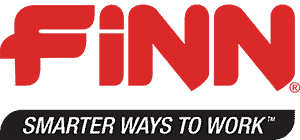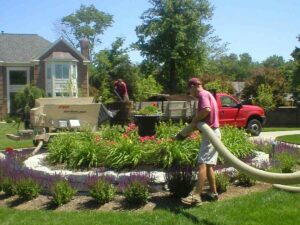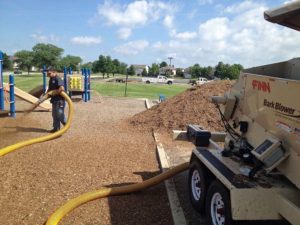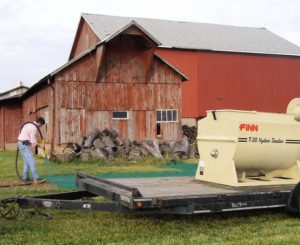How to Select the Right Hydroseeding Equipment
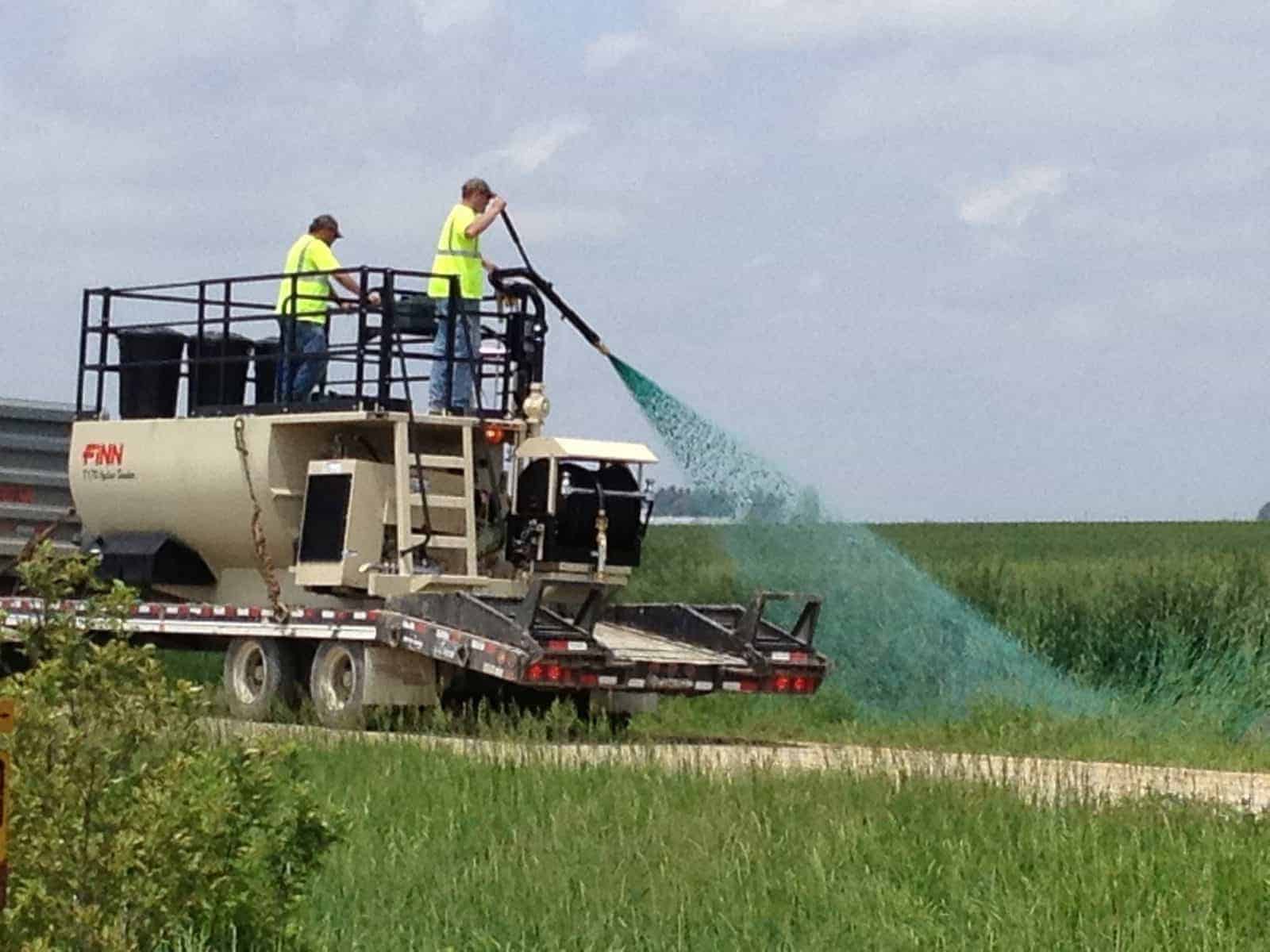
Share this article!
Hydroseeding technology has become more widespread as the benefits of this fast, efficient seeding method have spread across the landscaping industry. With tens of thousands of landscaping contractors nationwide, small and medium-sized landscaping companies explore hydroseeders to expand services and grow the business.
While hydroseeding may seem simple, there are many factors to consider before purchasing or renting equipment. It’s not as simple as just mixing some water, seed, mulch, and fertilizer and spraying it on the ground. If you’ve considered adding hydroseeding to your business’s service offerings, here are some key questions to ask yourself, as well as the answers you’ll need to get started.
What size of a machine do you need?
Finn hydroseeder tank sizes range from about 300 gallons in the T30 Hydroseeder to nearly 4,000 gallons in the Titan HT400 Hydroseeder, with discharge distances of 70 feet to more than 365 feet. Naturally, the size of the project will influence the size of the hydroseeder best suited for it. A multi-acre job site will require a larger unit to reduce the number of stops to refill the tank. On the other hand, a small- to medium-sized landscaping contractor business that seeds residential and small sites can likely serve customers with the smaller equipment.
The location of the job site and the available water source are important factors, as well. Larger, skid-mount-only hydroseeders are typically hauled with a multi-axle truck. Small and midsized hydroseeders are available in trailer or skid configurations, with the smallest unit able to fit into the bed of a pickup truck. These sizes range from 600 to 1,200 gallons and are great for a variety of projects. Consider the site access and the capabilities of your carrier vehicle, and then select the hydroseeder that best fits your project and business needs.
What are the material needs of the job?
Hydroseeders use a mixture of water, grass seed, mulch, and fertilizer to create a slurry mixed by the powerful agitators. This mixture is sprayed through a hose or boom onto the prepared ground to begin growing vegetation and promoting erosion control. The type of mulch needed for a job site will vary based on different factors, and the type of mulch will determine what hydroseeder is appropriate for the work.
Mulch materials include wood mulch, paper mulch, wood and paper blend, Bonded Fiber Matrix (BFM) and Flexible Growth Matrix (FGM). Additives and tackifiers also may be added to the mixture. Tackifiers help the slurry mixture stick to the application area to prevent slippage of the applied materials. For example, a job site with hills and berms will need a thick slurry with a tackifier to ensure the mulch and seed stick to the hillside.
Mechanical agitation or Jet agitation?
Both jet and mechanical agitation systems have some advantages and disadvantages. The most significant difference between jet and mechanical agitation is the type of material each can process. Hydroseeders with mechanical agitation use large steel paddles to break up and mix the materials. Alternatively, jet agitation uses water nozzles inside the tank to break up materials. This difference dictates the type of material each can process.
Mechanical agitation systems are easier to load and can use a thicker slurry, which means your team can apply more material in less time. In addition, mechanical agitation units, depending on the machine’s size, can spray the slurry over 360 feet through the boom. The hose allows for tight control of the spray pattern as well as distance, depending on its length. However, mechanical agitation hydroseeders have more complex mechanics and require more service, including daily maintenance like greasing the pump and shaft bearings. While one person can operate a mechanical agitation unit, many prefer to work in teams of two when hydroseeding.
Jet agitation systems tend to be easier to use for one person and are less expensive to own and operate. They have fewer moving parts, meaning these units are easier to service. However, jet agitation hydroseeders cannot handle 100% wood mulch, FGMs and BFMs. These types of mulch are often necessary for job sites where erosion concerns or extreme temperature and moisture concerns are prominent. Jet agitation is designed for paper and some wood-paper mulch mixes. To load a jet agitation machine, the operator must break up the mulch bale as it is being loaded into the tank to allow for proper incorporation into the slurry. Plus, jet agitation machines are also limited on how thick a slurry can be mixed, which can have an effect on the application rate.
While there are pros and cons to mechanical and jet agitation, all FINN Corporation hydroseeders utilize mechanical agitation because it has more versatility in the materials it can mix.
How much can you afford?
New jet agitation hydroseeders can cost as little as $3,000 for a very small machine. Prices quickly escalate north of $150,000 with the largest mechanical agitation hydroseeders. It’s a significant investment, but depending on the jobs you’re bidding on, you must have the right-sized machine. A small- to medium-sized landscaping company could consider three possibilities:
- Rent a hydroseeder. Many dealers have rental programs, allowing you to expand your business during peak seasons. For example, a small- to medium-sized landscaping business with a hundred seeding jobs may opt to rent a small hydroseeding unit to expedite the work. The reduction in labor and material costs may offset the price of the rental.
- Purchase a smaller, used machine to test the waters and bid only jobs that the unit can handle efficiently. This method opens the door to growth and expansion through new business without jumping into the deepest end of the pool right away.
- Develop a business plan around jobs that require a larger machine. Maybe your landscaping business is on the cusp of significant growth, but it needs the right equipment to handle larger jobs. Starting with a bit more allows your business to go after bigger jobs.
In addition to the cost of the hydroseeder, don’t forget to account for material costs. Be sure you can source the materials necessary for proper application at the job site.
Find the hydroseeder to meet your needs.
Hydroseeders can make quick, efficient work of seeding job sites both large and small. However, it’s essential to understand the equipment that is best suited to the jobs you plan to bid. Small and medium-sized businesses have an opportunity to grow by adding a hydroseeder to their fleet. Thinking about and answering these questions will help you decide whether it’s the right move for your business.
If a hydroseeder is in your future, take a look at FINN’s hydroseeders and contact a dealer near you to find the best option to cover some ground.
Folow Finn Corporation on Social
How to Lay Mulch Evenly – When & Why to Use a Mulch Blower
Understanding the best way to spread mulch evenly can mean the difference between a great-looking, environmentally-friendly landscape, and one that falls short in both areas. From spreading mulch basics to how to spread mulch evenly, and when to use a mulch blower to achieve the desired results, these landscaper insider tips can help elevate your next project’s aesthetics and help…
Bark & Mulch Blowing 101
One of the best ways to enhance soil composition, prevent erosion, and improve the aesthetics of any landscaping project is to utilize bark and mulch blowing. For our purposes, bark and mulch blowing are effectively the same thing, and can generally be used interchangeably. Bark and mulch are both great choices to prevent weed growth and invasion, improve soil quality…
Hydroseed vs. Sod vs. Grass Seed
If you’re starting a lawn from scratch, you’ve probably come across the three common methods for seeding: sod, grass seed, and hydroseed. In order to determine the best choice for your yard, you may want to ask yourself a few questions before you get started, and familiarize yourself with each of the processes so you can make the right choice…
